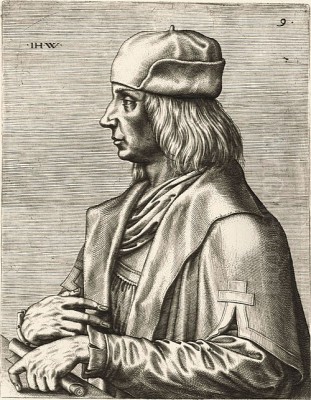
Quentin Massys, also spelled Matsys or Metsys, stands as a pivotal figure in the art history of the Low Countries. Active during the late 15th and early 16th centuries, he is widely regarded as the founder of the Antwerp School of painting, a dominant force in Northern European art. His life and work represent a fascinating bridge between the late Gothic tradition of Flemish masters and the burgeoning influence of the Italian Renaissance, creating a unique synthesis that profoundly shaped the course of art in the region. His versatility encompassed deeply felt religious scenes, insightful portraits, and pioneering genre paintings often laced with satire and moral commentary.
Early Life and the Leuven Years
Pinpointing the exact birth year of Quentin Massys remains a subject of minor scholarly debate, but the consensus places it around 1465 or 1466. He was born in Leuven (Louvain), an important university city in the Duchy of Brabant, now part of modern-day Belgium. His family background is traditionally linked to metalworking; his father, Joost Massys, was reportedly a blacksmith or clockmaker. This connection fueled a romantic, though likely apocryphal, legend about Quentin's own path to painting.
The story goes that Quentin was initially trained as a blacksmith but fell in love with a young woman whose father, an artist, would only consent to the marriage if Quentin became a painter himself. Driven by love, he supposedly abandoned the forge for the brush and quickly excelled. While this tale adds a layer of romance, historical evidence suggests a more pragmatic, though still somewhat obscure, transition. It is plausible that his early training in metalwork provided him with a strong sense of form and precision that later benefited his painting.
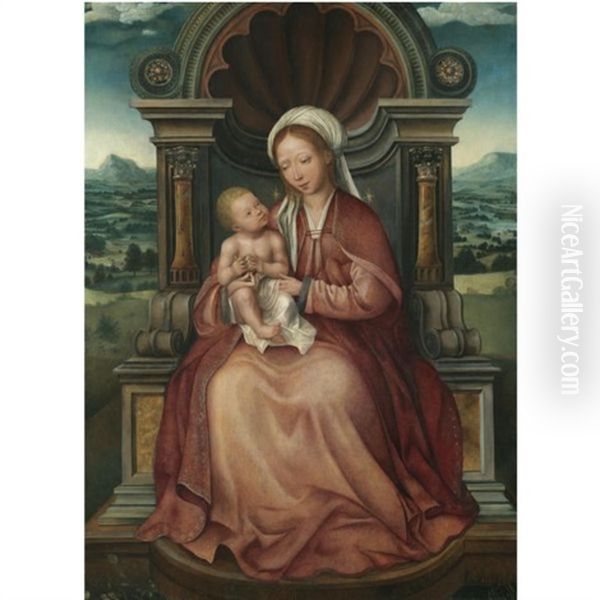
Details about his artistic training in Leuven are scarce. No definitive records name his master. However, given Leuven's artistic environment, it's often speculated that he may have had contact with the workshop of Dieric Bouts, a leading painter active in the city until 1475, or perhaps with Bouts's sons, Aelbert and Dieric the Younger, who continued the workshop. The influence of earlier Flemish masters like Rogier van der Weyden and Hugo van der Goes can also be discerned in the meticulous detail and emotional depth found in his later works, suggesting a thorough grounding in the established Netherlandish tradition.
Antwerp: A New Beginning and Rise to Prominence
Around 1491, Quentin Massys made a decisive move to Antwerp. This city was rapidly eclipsing Bruges as the economic and cultural hub of the Low Countries, attracting merchants, financiers, intellectuals, and artists from across Europe. In that same year, Massys was admitted as a master into the prestigious Guild of Saint Luke, the city's guild for painters and sculptors. This membership marked his official establishment as an independent artist in a thriving metropolis.
His arrival coincided with a period of significant artistic ferment in Antwerp. Massys quickly rose to become one of the city's leading painters. His workshop flourished, attracting apprentices and producing works for a diverse clientele, including religious institutions, wealthy merchants, and humanist scholars. His reputation grew steadily, solidifying his position not just as a skilled craftsman but as an innovative artist shaping the city's burgeoning artistic identity. He is often credited as the first major painter to truly define the "Antwerp School," characterized by its dynamism, embrace of new influences, and often, a more dramatic or expressive style compared to the earlier Bruges school.
Massys's personal life during this period also saw changes. His first wife, Alyt van Tuyl, whom he married around 1492, bore him several children before her death around 1507. He remarried shortly thereafter, to Catharina Heyns, with whom he had ten more children. Among his offspring were two sons who would follow in his footsteps and become notable painters themselves: Jan Massys and Cornelis Massys.
Artistic Style: A Synthesis of North and South
The hallmark of Quentin Massys's art is its masterful synthesis of Northern European traditions and Italian Renaissance innovations. He retained the meticulous attention to detail, rich textures, and jewel-like colours characteristic of Flemish masters like Jan van Eyck and Rogier van der Weyden. However, he integrated these elements with a newfound monumentality, a greater interest in classical forms, and a deeper psychological penetration often associated with Italian art, particularly the work of Leonardo da Vinci.
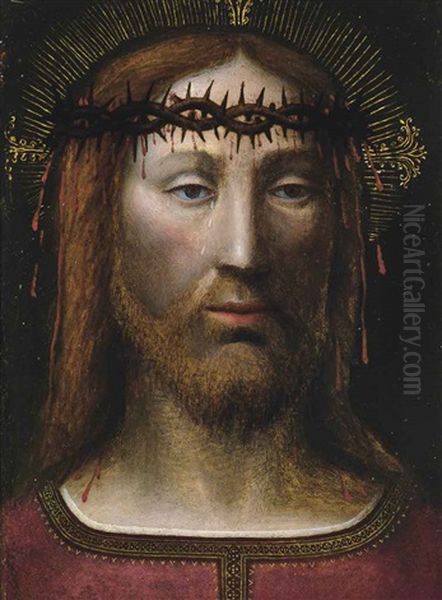
Massys did not simply copy Italian models; rather, he adapted them to his own sensibility and the tastes of his Northern patrons. His figures often possess a physical presence and emotional complexity that moves beyond the more restrained piety of earlier Flemish painting. He demonstrated a keen understanding of human anatomy and perspective, arranging figures in dynamic and often complex compositions. His use of light and shadow (chiaroscuro) became more sophisticated, employed not just for realism but also for dramatic effect and emotional emphasis.
This unique blend allowed Massys to tackle a wide range of subjects with freshness and authority. He revitalized traditional religious themes, brought new psychological depth to portraiture, and played a crucial role in the development of secular genre painting. His ability to navigate between these different modes cemented his reputation as a versatile and forward-looking artist.
Religious Masterpieces
Despite the growing market for secular art, religious commissions remained central to Massys's output, particularly during the first two decades of his Antwerp career. His two most celebrated large-scale religious works are monumental triptychs that showcase his mature style. The Triptych of Saint Anne, also known as The Holy Kinship, was commissioned in 1507 for the Church of Saint Peter in Leuven and completed in 1509. Now housed in the Royal Museums of Fine Arts of Belgium in Brussels, it depicts the extended family of Christ with warmth and dignity, set within an impressive Renaissance architectural framework. The figures interact with a naturalness and emotional resonance that marks a departure from earlier, more rigid depictions.
Equally significant is the Lamentation Triptych, painted between 1508 and 1511 for the Antwerp carpenters' guild chapel in the city's cathedral. Now located in the Koninklijk Museum voor Schone Kunsten Antwerpen (Royal Museum of Fine Arts Antwerp), this powerful work depicts the deposition of Christ from the cross. The central panel is a scene of intense grief and pathos, with figures displaying a range of emotional responses rendered with remarkable sensitivity. The side panels depict the martyrdoms of Saint John the Baptist and Saint John the Evangelist, executed with dramatic flair and gruesome detail, reflecting a Northern taste for vivid narrative. Both triptychs demonstrate Massys's skill in handling complex multi-figure compositions and his ability to convey profound religious feeling.
Insightful Portraiture
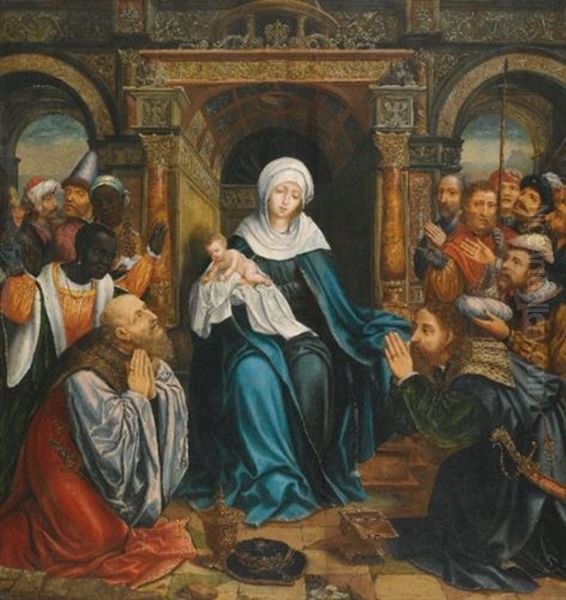
Quentin Massys was also a highly sought-after portraitist. His portraits are noted for their sharp observation, capturing not only the physical likeness of the sitter but also conveying a sense of their personality and social standing. He moved beyond the purely objective representation common in earlier Flemish portraiture, infusing his subjects with a greater sense of interior life, likely influenced by the psychological depth seen in portraits by Leonardo da Vinci.
Among his most famous portraits are those connected to the vibrant humanist circles of Antwerp and Europe. Around 1517, he painted companion portraits of the renowned Dutch humanist Desiderius Erasmus and his friend Petrus Aegidius (Pieter Gillis), the town clerk of Antwerp and a central figure in its intellectual life. These portraits were intended as a gift for the English humanist Sir Thomas More. The portrait of Erasmus (versions exist, including one at Hampton Court Palace and another at the Galleria Nazionale d'Arte Antica, Rome) depicts the scholar at work, emphasizing his intellectual pursuits. The portrait of Gillis (Longford Castle collection) shows him holding a letter from More, visually cementing the network of humanist friendship. These works are invaluable not only as artistic achievements but also as historical documents of the Northern Renaissance intellectual milieu.
Massys's portraits often feature detailed settings or symbolic objects that provide context for the sitter. His meticulous rendering of textures – fabric, fur, wood, metal – adds to the realism and richness of the images. He captured the growing self-awareness and status of the individuals who were shaping the cultural and economic life of Antwerp.
Genre Painting and Satire
Perhaps one of Massys's most significant contributions was his pioneering work in genre painting – scenes of everyday life, often imbued with moralizing or satirical undertones. These works catered to a growing urban audience interested in depictions of contemporary society, its virtues, and its vices. His most famous work in this vein is The Money Changer and His Wife (1514), now in the Louvre Museum, Paris. It depicts a man weighing coins while his wife, ostensibly reading a devotional book, glances sideways at the money. The painting is rich in detail and symbolism, often interpreted as a commentary on avarice and the tension between worldly pursuits and spiritual devotion, a theme highly relevant in the bustling commercial centre of Antwerp.
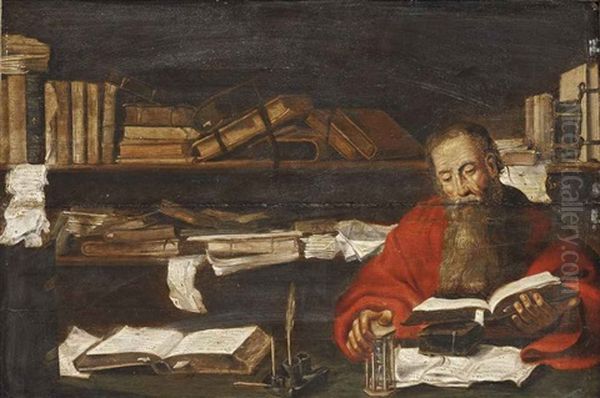
Another striking, and somewhat notorious, work is An Old Woman, commonly known as The Ugly Duchess (c. 1513), housed in the National Gallery, London. This unflattering portrait depicts an elderly woman with exaggerated, almost grotesque features, dressed in aristocratic attire that seems incongruous with her appearance. It is believed to be based on caricature studies by Leonardo da Vinci, whom Massys likely knew through drawings or prints. Whether intended as pure satire, a commentary on vanity, or perhaps even a depiction of a medical condition (Paget's disease has been suggested), the painting is a powerful and unsettling image that pushes the boundaries of portraiture. These genre and satirical works were immensely popular and widely copied, influencing artists like Marinus van Reymerswaele, who specialized in similar themes.
The Influence of Italy and Humanism
The impact of the Italian Renaissance on Quentin Massys is undeniable, though the exact nature of his exposure remains debated. While there is no firm evidence that he ever travelled to Italy himself, Italian art and ideas circulated widely in Antwerp through prints, drawings, and the presence of Italian merchants and artists. The influence of Leonardo da Vinci is particularly apparent, not only in the sfumato (soft, hazy transitions between colours and tones) that sometimes appears in Massys's work but also in the psychological complexity of his figures and his interest in caricature and expressive physiognomy.
Beyond specific artistic techniques, Massys was deeply connected to the humanist movement of the Northern Renaissance. His friendships with Erasmus and Pieter Gillis placed him at the heart of intellectual life in Antwerp. Humanism, with its emphasis on classical learning, individual potential, and critical engagement with the world, likely resonated with Massys's own artistic explorations. His portraits of humanists, his engagement with moralizing themes, and his realistic depiction of the contemporary world can be seen as reflecting this broader cultural shift. He was an artist participating in, and contributing to, the intellectual currents of his time.
Workshop, Collaborations, and Artistic Lineage
Like most successful masters of his era, Quentin Massys operated a large and productive workshop in Antwerp. He trained numerous apprentices, ensuring the dissemination of his style and techniques. His influence extended directly through his own sons, Jan Massys (c. 1509–1575) and Cornelis Massys (c. 1510–c. 1557). Jan often continued his father's style, particularly in elegant, sometimes Mannerist-influenced, secular and mythological scenes. Cornelis became known primarily as a landscape painter and printmaker, contributing to the development of landscape as an independent genre.
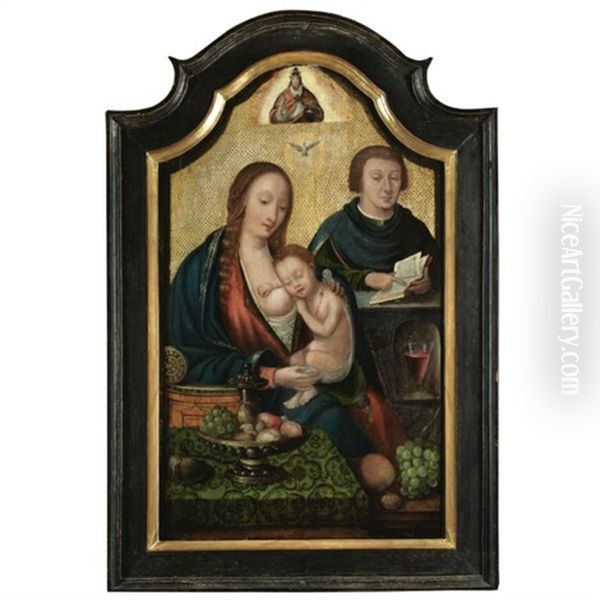
Collaboration between artists was common practice in Antwerp, particularly between figure painters and landscape specialists. While concrete proof is often elusive, it is highly probable that Massys collaborated with Joachim Patinir (c. 1480–1524), a pioneering landscape painter also active in Antwerp. In some works attributed to Massys, the expansive and atmospheric landscapes bear the hallmarks of Patinir's style, suggesting Patinir may have painted the backgrounds while Massys focused on the figures. This collaborative spirit was characteristic of the efficient workshop system in Antwerp.
Massys's influence extended beyond his immediate circle. His development of genre themes, particularly those involving merchants, tax collectors, and satirical figures, was taken up by followers like Marinus van Reymerswaele. His broader impact on the Antwerp School helped pave the way for the next generation of Flemish masters, including Pieter Aertsen and Joachim Beuckelaer, who further developed genre painting, and ultimately influenced the great Pieter Bruegel the Elder, whose depictions of peasant life and social commentary owe a debt to Massys's pioneering work.
Encounters with Contemporaries
Antwerp's status as an international hub meant Massys likely encountered artists from other regions. A notable documented meeting occurred in 1520 when the celebrated German artist Albrecht Dürer visited Antwerp during his journey through the Netherlands. Dürer's diary records his interactions with Massys, whom he clearly respected, referring to him as "the painter." Dürer drew a portrait of Massys (though the original is lost) and exchanged gifts and artworks. This encounter highlights Massys's established reputation and his position within the wider network of leading Northern European artists, which also included contemporaries like Jan Gossaert (Mabuse), Bernard van Orley, Lucas van Leyden, and Jan van Scorel.
Later Life and Enduring Legacy
Quentin Massys remained active and highly regarded until the end of his life. He continued to receive important commissions and run his successful workshop. He died in Antwerp in 1530, likely sometime between mid-July and mid-September. He was buried in the Cathedral of Our Lady, a testament to his standing in the city.
His legacy is multifaceted. As the effective founder of the Antwerp School, he played a crucial role in establishing the city as the dominant artistic centre of the Low Countries for much of the 16th century. His ability to synthesize the meticulous realism of the Flemish tradition with the innovations of the Italian Renaissance created a powerful and influential style that bridged the late Gothic and Renaissance periods in Northern Europe.
He revitalized religious painting with greater emotional depth and compositional dynamism. He advanced the art of portraiture, capturing the psychological presence of his sitters with unprecedented insight. Furthermore, his exploration of genre scenes and satirical themes opened up new avenues for artistic expression, reflecting the social and economic realities of his time and paving the way for later masters of genre painting. His influence was felt not only by his sons and direct followers but also by subsequent generations of Flemish and Dutch artists.
Conclusion: A Master of Transition
Quentin Massys the Elder occupies a vital position in the history of Northern European art. He was an artist of remarkable skill and versatility, comfortable working across religious, portrait, and genre subjects. Living and working during a period of profound cultural and artistic change, he navigated the transition from the late medieval world to the early modern era with exceptional talent. By selectively integrating the lessons of the Italian Renaissance while remaining rooted in the rich artistic heritage of Flanders, he forged a unique and influential style. As the leading figure of the early Antwerp School, his work not only defined the artistic character of his city but also left an indelible mark on the future course of painting in the Low Countries and beyond. His masterpieces continue to engage viewers with their technical brilliance, emotional power, and insightful commentary on the human condition.